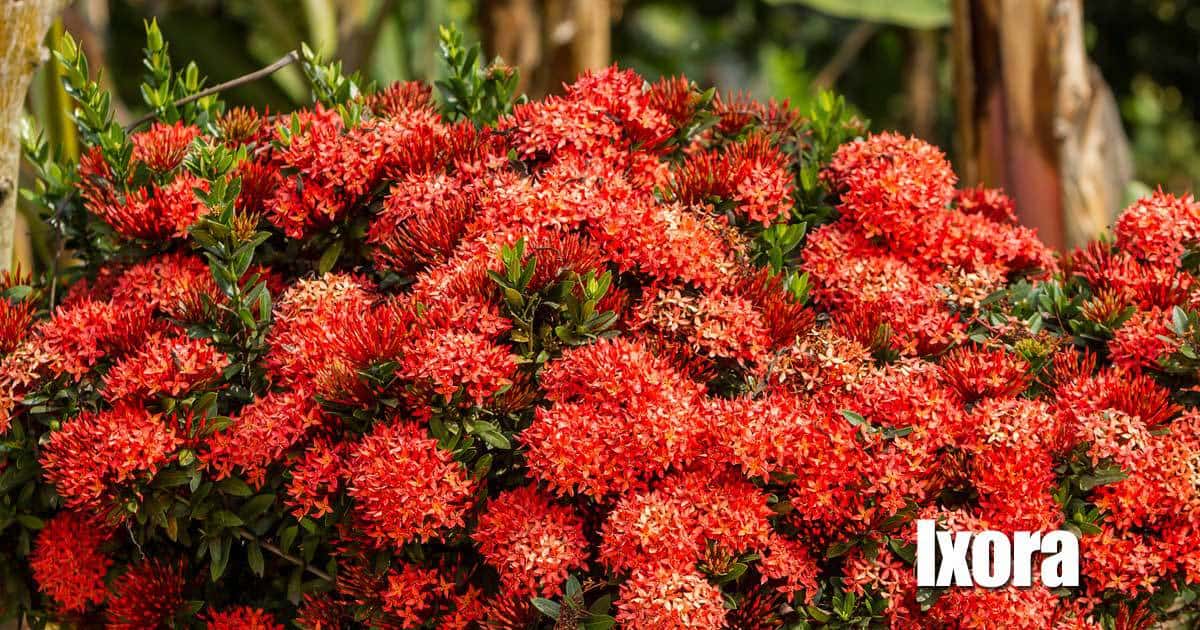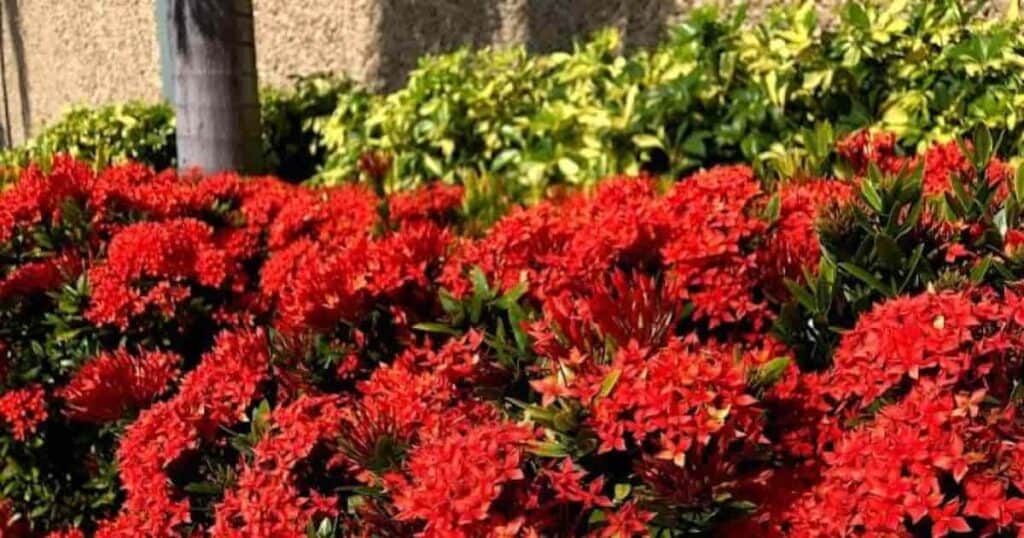Known as Ixora Taiwanensis, or by the common name Dwarf Ixora plant, the showy flowers make it a fabulous accent plant and small accent shrub.

The Ixora plant is loved by many because it produces clusters of star-shaped flowers and bright flowers all year round.
Ixora Taiwanensis Quick Care Tips
- Botanical Name: Ixora Taiwanensis
- Common Name(s): Dwarf Ixora
- Synonyms: Ixora chinensis, Ixora coccinea
- Pronunciation: ix-OR-a
- Family & Origin: Rubiaceae family, native to tropical Asia and Africa
- Growability: Easy to grow
- Grow Zone: 9-11
- Size: Grows up to 2′ to 3′ feet tall and 3’-4’ feet wide
- Flowering: Blooms year-round with clusters of star-shaped flowers
- Light: Direct sunlight
- Humidity: Prefers high humidity
- Temperature: Thrives in warm temperatures between 65° to 70° degrees Fahrenheit
- Soil: Moist, organically enriched, and well-drained acidic soil
- Water: Keep soil consistently moist but not waterlogged
- Fertilizer: Feed with an acid-loving fertilizer in spring and summer
- Pests & Diseases: Susceptible to thrips, aphids, and mealy bugs. May also be prone to root rot if overwatered.
- Propagation: Can be propagated through stem cuttings or seeds
- Plant Uses: Ideal for borders, hedges, and container gardens. Can also be used as a houseplant.
A Cluster Of Flower Buds
Each cluster consists of flower buds that come in red, yellow, pink, or orange color.
Clusters of these charming blooms are scattered randomly throughout the whole plant and are usually seen at the tip of the upright stems of the dwarf plant.
These bright flowered plants can make excellent ornamental plants, but to grow them successfully, there are some important steps to follow.
Dwarf Ixora are popularly used as low hedges (2′ to 3′ feet tall and 3’-4’ feet wide) because of their ixora shrub form and compact appearance.
This flowering shrub in a pot looks attractive when it blooms profusely. However, after blooming, it will take some time for the Ixora to re-bloom.
Ixora as Outdoor Plant
Reverse the old saying, “You can’t see the forest for the trees,” and you’ll have one that applies to hedges: “You can’t see the plants for the hedge.”
How often do you really see the individual plants instead of the overall symmetry of the planting?
Long before Ixora was used as a house or outdoor plant, I saw the larger Ixora plant with bright red flowers used as a formal hedge in southern Florida.
I remarked to a friend who was with me that I thought it would make a beautiful plant for my indoor garden up north, and she looked at me obliquely, wondering whether I was joking or had had too much sun!
Ixora Species
Some notable Ixora species under the Rubiaceae family include:
- Ixora coccinea (Dwarf santan)
- Ixora finlaysoniana
- Ixora taiwanensis (Dwarf ixora)
- Ixora macrothyrsa
- Ixora pavetta (torch tree)
- Ixora brachiata

Dwarf Ixora Plants Care
Ixora is an evergreen flowering accent shrub in a pot with glossy green opposite leaves.
As you might expect from its use as a hedging material, it can be cut back severely or shaped whenever necessary.
Ixora plant care is negligible, which makes it useful as part of the low-maintenance landscape.
If you want to trim the perennial semi-tropical flowering accent shrub, you should prune it after the first freeze if you reside in a cold area.
To get rid of sooty mold, you must spray the dwarf plant with neem oil or a neem wash. Do not water the dwarf plant until it needs water.
They can also be propagated through stem cuttings or seeds.
Tropical Evergreen Ixora
Never allow the evergreen Ixora accent shrub to become root-bound in a pot smaller than the ultimate size you want it in, and pot large plants firmly in coarse, turfy material.
It’s a tropical evergreen shrub that produces crowns of flowers in red-orange color.
Established and healthy plants usually produce three colorful flower crops a year. But, with Ixora hedge flowers being so long-lasting and having such a short resting period, indoor plants bloom almost constantly and start flowering when small.
Varieties Of Ixora Plants
The most commonly seen variety has – scarlet flowers, and other varieties produce clusters of pure white, pink, red (dwarf red Ixora), and orange.
For orange flowers, look for ‘Maui,’ which is thought to be colder tolerant than other varieties, or ‘Prince of Orange.’
If you’re looking for a bright, beautiful, alluring accent shrub, the Red Ixorda Dwarf is for you. Plant it in your garden for amazing blooms!
These names help you create an image of the flower: it has a very colored bloom that you will find in orange, red, pink, and yellow.
The earliest blooms are extremely showy, having long, slender-tubed corollas with four (sometimes five) wide-spread lobes and borne in full heads. It has large, salmon-pink flowers and glossy green leaves.
Best Soil For Ixora
As a tropical flower plant, Ixora prefers evenly moist soil and will suffer if the soil is allowed to dry out excessively.
These acid-loving plants prefer acidic soil over alkaline soil. Conduct a soil test to make sure the potted plants get the right kind of soil moist to thrive on.
The best soil for an indoor Ixora is an equal mix of perlite, all-purpose potting soil, and peat moss.
Ixora dwarfs need good water and regular liquid feedings when actively growing.
Plant Ixora bushes in well-drained soil to help lessen the effects of accidental over-watering. Either sun (not full sun) or partial shade agrees with this tropical plant.
Sunlight For Blooms
Direct sunlight is best because it utilizes the sun’s energy to grow all of its bright, beautiful blooms.
Plant Ixora in moist, organically enriched, and well-drained acidic soil with abundant sunlight and humidity for optimum growth and flowering.
If you don’t get at least 6 hours of sunlight throughout the year, the warm temperatures won’t be enough to make them bloom.
If you want to adjust the soil acidity for an indoor plant, try watering it for a few days with a mix of two tablespoons of regular vinegar per gallon of water.
While good fabric lets water through, it can still inhibit some airflow and ultimately reduce soil quality.
Mine hasn’t seemed particular about the temperature, although 65° to 70° degrees Fahrenheit is suggested for them.
My plant has resisted our newest indoor pest, thrips, aphids, and mealy bugs, and seems equally resistant to scale and whiteflies, but if these insects should appear, standard remedies may be used.
If you are searching for a small and colorful shrub with easy maintenance, Dwarf Ixora is a perfect option.
If you’re not sure where or how to plant the Dwarf Ixora in your hard, consult our landscaping team, who can help plant and install this amazing shrub for you.
